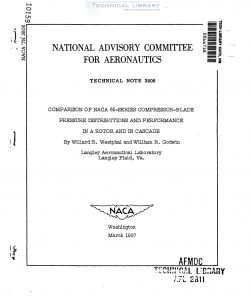naca-tn-3806
- Version
- 168 Downloads
- 1.34 MB File Size
- 1 File Count
- January 31, 2017 Create Date
- January 31, 2017 Last Updated
National Advisory Committee for Aeronautics, Technical Notes - Comparison of NACA 65-Series Compressor-Blade Pressure Distribution and Performance in a Rotor and in Cascade

An investigation has been conducted to compare the performance of
NACA 65-series compressor blades in two—dimensional cascade with that in
an axial-flow compressor. The entering and leaving flow velocities,
pressure rise, and the pressure distribution on the rotating blades were
measured at three radial stations of a free—vortex rotor. The blade
pressure distributions were obtained by the use of a mercury-seal pressure—
transfer device. The data obtained were compared with similar data for
the same blade sections obtained from a two-dimensional porous—wall.
cascade tunnel.
The comparison indicated that cascade data accurately predicted
the turning angle and blade pressure distribution obtained in the com»
pressor at design conditions. At other than design angle of attack,
large differences, prdbably due to secondary flows, were observed near
the inner casing.
A prime factor in the design of a turbomachine is the knowledge of
rotor-blade aerodynamic performance. However, blade profiles may be
tested and.evaluated much more easily in cascade than in a rotating
machine since models are simpler and compressor design parameters, such as
blade camber and solidity, are more easily varied in the cascade. Also,
the section characteristics such as lift, drag, and pressure distribution
are more easily measured in cascade. Unfortunately, flow through a two—
dimensional cascade is somewhat different from that through a rotating
machine since such three-dimensional phenomena as radial displacement
of the main flow, centrifuging of the boundary layer, and the tip clear—
ance leakage do not occur in cascades. A correlation is needed between
the simpler two—dimensional cascade flows and the flows through rotating
blade rdfis. One method of obtaining information for this correlation
is to measure the pressure distributions and flow velocities on rotating
blade roWs. In reference 1, Weske presented pressure distributions
measured on rotating blades, but did not present cascade data for com—
parison.
| File | Action |
|---|---|
| naca-tn-3806 Comparison of NACA 65-Series Compressor-Blade Pressure Distribution and Performance in a Rotor and in Cascade.pdf | Download |

Comment On This Post